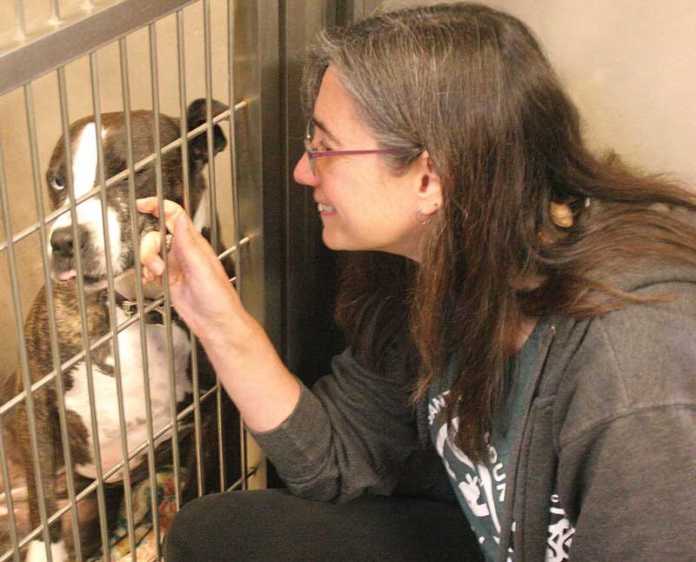SANTA CRUZ COUNTY — Every year, the Santa Cruz County Animal Shelter takes in thousands of animals at its two locations, a menagerie that can include cats and dogs, rabbits and snakes, horses and hamsters.
A trio of playful goats resides there, as does Lydia the potbellied pig.
The varied population comes thanks to the shelter’s open-admission policy, said Education Coordinator Jen Walker.
“We take all domestic, exotic or farm animals,” she said. “We have all sorts of animals waiting for homes.”
Walker said that about 75 percent of the 5,000 animals that come through the doors are strays, either simply lost or homeless.
The rest have been surrendered by their owners, or come from situations in which animals have been legally removed.
Despite attempts by shelter staff and volunteers to return the animals to their owners, just one-third of dogs go home, and fewer than 10 percent of cats, Walker said.
While the animals are at the shelters in Watsonville and Santa Cruz, however, they have plenty of care.
The shelter gets most of its funding through the animal control and shelter services it provides for the county. But the rest of the services — such as education, low-cost spay and neuter clinics and shot fairs — are funded through grants and by private donations from the community, Walker said.
A team of about 400 volunteers provides care of them and such services as foster care, landscaping, grooming and taking photographs for found-animal notices.
Volunteers also help provide outreach and education programs, which play a vital role in the organization’s mission: reducing the animal overpopulation problem and keeping them out of shelters entirely.
This requires an understanding from the public about the scope of the problem, and how they can help, Walker said.
“We cannot adopt or spay/neuter our way out of this problem,” she said. “We need to change the culture.”
Animal Control Officer Rodolfo Manriquez said that 50 percent of calls for service come from Watsonville, where he frequently tries to convince residents that he and his fellow officers are not out to punish pet owners who find themselves on the wrong side of animal regulations.
One problem in South County is that many residents come from Mexico, where “la perrera” — the pound — is known for forcibly removing animals and frequently euthanizing them.
They therefore avoid contact with the very people who can help them.
In fact, Santa Cruz County officials try to keep animals at their home whenever possible.
“I want to change that impression,” Manriquez said. “We’re here to help. I want to educate people about being responsible pet owners.”
To do that takes cooperation from the public, Manriquez said. He and his fellow officers strive to help residents understand the rules that keep their pets — and themselves — safe.
Keeping dogs leashed while walking, for example, not only prevents them from running away, but also stops them from blundering in front of oncoming traffic.
Spaying and neutering pets can significantly reduce the risk of cancer, stop a wide range of behavior issues and help reduce the overpopulation problem.
Manriquez said he also battles the social stigma that makes certain cultures reluctant to spay or neuter their animals.
The shelter also strongly encourages owners to microchip their animals.
Following a decision made by the Santa Cruz County Animal Shelter in 2013, the Watsonville City Council on Tuesday updated an ordinance that requires all dogs and cats within the city to be implanted with a microchip.
Roughly the size of a grain of rice, a microchip is an electronic chip that is injected under the animal’s skin, typically between their shoulder blades. It contains a number that is used to identify the animal, and studies have shown that microchipped animals are more likely to be reunited with their owners should they be lost, said Melanie Sobel, general manager of the animal shelter.
Citing a study of more than 7,700 stray animals, she said microchipped dogs were returned to their owners about 52 percent of the time, compared to roughly 22 percent of dogs that did not have a chip. Microchipped cats, meanwhile, went back home 38.5 percent of the time, compared to 1.8 percent of those without a microchip.
The animal shelter provides microchip implants for $15, compared to nearly $75 at a veterinarian, she added.
In late 2013, the Santa Cruz County Animal Shelter Board of Directors approved an ordinance that requires all dogs and cats over the age of four months to be implanted with a microchip, although exemptions are allowed, such as for medical reasons.
Watsonville’s updated ordinance states that if an impounded dog or cat is found without a microchip, the owner must pay for it to receive the implant.
Sobel said there is still a stigma surrounding microchips, with owners believing that it will cause long-term health effects for their pets, which she disputed.
“We want to change people’s behavior,” Sobel said. “They know it is the right thing to do, but they don’t necessarily do it until a law is there to enforce it.”
Also, she said requiring dogs and cats to have microchips is not an abuse of government power, but rather, it’s a way to save animals’ lives and reduce the costs associated with housing them at the shelter.
“It’s simply another tool for us to return pets to their owners as soon as possible,” Sobel said.
•••
The Santa Cruz County Animal Shelter headquarters is at 2200 Seventh Ave. in Santa Cruz. The Watsonville branch is at 580 Airport Blvd. For information, visit www.scanimalshelter.org or call 454-7200.












